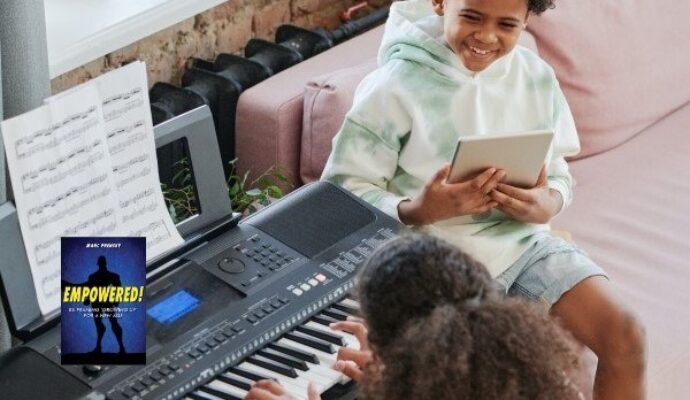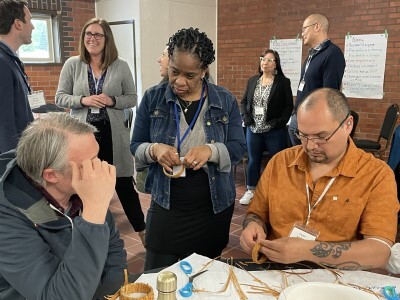Re-Framing Who Young People Are, Part 1
Topics

Next generation learning is all about everyone in the system—from students through teachers to policymakers—taking charge of their own learning, development, and work. That doesn’t happen by forcing change through mandates and compliance. It happens by creating the environment and the equity of opportunity for everyone in the system to do their best possible work.
EMPOWERED! Chapter 4
When we see technology only as a tool that we can pick up or put down, and not a new central component of our being human, we may miss the most empowering opportunities available to young people.
Note: This article is a reprint of the first half of “Chapter 4: Re-Framing Who Young People Are” of the author’s book, EMPOWERED! Re-framing ‘Growing Up’ for a New Age. You may want to start with Chapter 1.
From “Humans with Tools” to
“SYMBIOTIC EMPOWERED HYBRIDS”
Now that we have re-framed the times in which young people live as the New Age of Empowerment, we can look to re-frame who humans are in that Age—re-framing both who young people have already become in many cases, and who they all are in the process of becoming. A dramatic increase in human capabilities is already underway, largely because of technology. It is therefore helpful to re-frame how we see the relationship of technology and humans.
Seeing Technology as a “Tool” Is No Longer Helpful
The frame I most often hear for the relationship between humans and technology is that of people with tools. Most often these are seen as “optional” tools that humans can, with more difficulty perhaps, do without. “Tools are neutral,” some also say. “They can be used for good or for bad.” The problem is that one can say exactly the same thing about humans. So what?
I believe the frame of seeing technology as an optional, neutral tool is no longer helpful. In fact, framing “humans as the core” and “technology as an optional addition” is no longer even an accurate perspective. Already, in my view, and going forward, technology has already become, and will continue to become a symbiotic part of 21st century humans. It is already well down the road to becoming that today in many situations and places.
The re-frame we need is:
From technology as a tool, and humans in competition with it... To humans becoming SYMBIOTIC EMPOWERED HYBRIDS with our technology.
Becoming symbiotic is hugely empowering.
Of course, humans are not the only species that uses tools. But as human “tools” progressed from sticks, to fire, to domestic animals, to extremely complicated machines—both helpful and destructive—they became more and more a part of us. How useful is a plumber without his tools? The use of tools enabled humans to extend and project our power far beyond our physical bodies and limitations.
But a big element of humans’ frame for these tools, up until now, is the idea that they are not part of humans’ “essence.” In that now-expiring frame, anything that has not biologically evolved “inside us” is just a “mere tool” that we have created and taught ourselves to use. Although these tools make us more powerful, they do not make us more human.
This is, essentially, a religious framing—of our relationship to “our maker” or to nature. In this frame, our body (including, of course, our brain)—along with, perhaps, some vaguely-defined spirit—completely comprises all of “who we are.” At our core sits a “human essence”—which some connect directly with forces in the universe. Take away all our tools, and the human still remains.
Put Devices Down?
Ironically, as our technology becomes more and more powerful, we hear many adults asking young people (and in some cases all people) to put down their tools and shut off their technology—at least temporarily. I believe those asking for this do not yet realize that the old frame of humans with optional parts is changing—even biologically.
We now know a lot more about our biology, and particularly about the biome of microbes that lives in our gut and on our skin. All the bacteria in that biome—even the ones living in our gut—are actually on the outside of our blood-fed body, because we have a tube (the digestive system) running completely through us, and the bacteria are inside the tube. (This was a huge re-frame for me when I learned about it.) True, we didn’t create the bacteria. But are they a “mere tool,” created by nature? Or are they a part of us? Would it help us to “turn them off” from time to time? Doubtful. It would almost certainly lead to our demise.
I believe we will be better served, in our New Age of Empowerment, by revising the frame of “just a tool”—not only for the bacteria, but for technology as well. Were we to take away from modern humans every last vestige of 21st-century technology they have today, including medical, dental, work tools, entertainment, and more, people, in most places, would no longer be 21st-century humans—they would be “humans of the past.” Some of these past human varieties still do exist in some places. While formerly we typically just wiped them out when we found them, we now go to great lengths to isolate and protect them and their way of life—both for their sake and as a kind of “museum” of our past. But although there will always exist a desire by some to live in earlier times, and although there will always be vestigial and atavist humans in corners of the modern world, most humans have already moved—or are quickly moving—to a new stage. We have been transformed by the environment we have created, and in which our young people will live.
Are We in Competition?
Some frame this new human stage—and Age—competitively. The 2011 book Race Against the Machine offers a frightening re-frame of the relationship of humans and technology as a competition between “humans” on the one side and “technology” on the other. Although the authors’ ideas are actually more nuanced than the title indicates, the frame of a war against technology has been adopted by not only authors and filmmakers but by many parents as they see their kids become more and more attached to their smartphones. A great many adults are seriously frightened by today’s young peoples’ behavior regarding technology.
Symbiosis Is a More Useful Re-Frame
But that behavior doesn’t need to be frightening. We can re-frame our new relationship with technology in a more useful and hopeful way than us versus them—even though that makes for good movie plots. We can also do so in a way that is far more helpful than saying “We now have more advanced tools but they are still optional.”
A far more useful re-framing is to view our relationship as a new form of symbiosis—producing a new kind of positive human-technology combination. I believe that to help our coming generations,
One of our greatest challenges is to make this symbiotic re-frame happen for them—and for all of us—as quickly and as completely as possible.
Why Symbiosis?
What is this re-framing I am talking about? What IS symbiosis? And why is it so important for our children to frame their relationship to technology in this different way?
A “symbiotic relationship” is one in which two things need and depend on each other, because neither can survive (or survive as well) on its own. The combination is far more robust and powerful than either.
Humans today, I think many would agree, are less powerful without technology. And, certainly, technology is less powerful without humans to maintain and improve it. Neither would survive—at least in its current form—without the other.
That makes their relationship symbiotic. We each benefit from the other, and the whole is far better.
Young People Have Already Started
Young people, of course, have already begun moving to symbiosis just as fast as they possibly can. Almost everyone knows how hard it is to take away a young person’s smartphone—parents try bribing and forcing their kids, teachers try oppressive rules. The young people get around both. Why is it so hard to take the technology away?
One theory is that the technology is addictive. I think, however, that that view, while common, is flawed. There are some things that the human body, once it experiences them, instantly craves—such as comfort. But we don’t call people “addicted” to comfort. There are also powerful drugs, such as those anesthetists use. Trying these only once in the wrong way can lead to addiction in almost anyone. (It turns out a surprising percentage of anesthetists become addicted to the drugs they use.)
Technology, however, is useful to humans. Wanting more of it is a form of natural selection—those who have it thrive.
Some critics portray the idea of adults “maliciously” making technology addictive—i.e., by giving young people “dopamine hits” like rats in a cage to addict them to games or other technology. While doing this is certainly not outside of the lengths some adults will go for money or power, I believe a far better analogy for technology’s worst effects are the negative effects gambling produces—it lures a small number to unhelpful behaviors, but not most.
That said, we should still pay attention, person-by-person.

Photo by cottonbro studio.
A More Useful Frame
A far more useful re-frame for technology is to see it not as an addictive substance or behavior, but more like humans having evolved a new body part. People with the technology now have something that is always with them that seriously extends their capabilities. It’s very much like having a new limb, with new fingers that can reach out around the globe to places you want to be.
Because the technology—this new human body part—is so new, we have hardly mastered its use. One’s real hand can be used both positively—to feed, caress, and pet—and also negatively—to punch, slap, and take what’s not yours. But when young people do those undesirable things, parents and teachers don’t cut young people’s hands off. (Some once did, perhaps, but now that’s considered barbaric.) What they now do instead is they help the young people use their body parts more positively and productively. From the young people’s point of view it is barbaric to take away their technology because they live in a new world—a world of symbiotic humans—where these things are a part of them.
Read More: EMPOWERED!
Continue to read Part 2 of Chapter 4.
- Chapter 1: Re-Framing Growing Up for a New Generation, Part 1 and Part 2
- Chapter 2: A New Generation Seeing Things in a New Way, Part 1 and Part 2
- Chapter 3: Re-Framing Our Young People’s Times, Part 1 and Part 2
- Chapter 4: Re-Framing Who Young People Are, Part 2
- Chapter 5: Re-Framing Where Young People Will Live, Part 1 and Part 2
- Chapter 6: Re-Framing What Young People Believe, Part 1 and Part 2
The full book is available on Amazon.
Photo at top by Boris Pavlikovsky.




